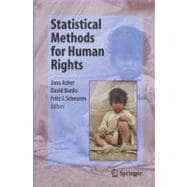
Note: Supplemental materials are not guaranteed with Rental or Used book purchases.
Purchase Benefits
| Statistical Thinking on Human Rights Topics | |
| Introduction | p. 3 |
| The Statistics of Genocide | p. 37 |
| Why Estimate Direct and Indirect Casualties from War? The Rule of Proportionality and Casualty Estimates | p. 51 |
| Statistical Thinking and Data Analysis: Enhancing Human Rights Work | p. 65 |
| Recent Projects | |
| Hidden in Plain Sight: X.X. Burials and the Desaparecidos in the Department of Guatemala, 1977-1986 | p. 89 |
| The Demography of Conflict-Related Mortality in Timor-Leste (1974-1999): Reflections on Empirical Quantitative Measurement of Civilian Killings, Disappearances, and Famine-Related Deaths | p. 117 |
| Afghan Refugee Camp Surveys in Pakistan, 2002 | p. 141 |
| Metagora: An Experiment in the Measurement of Democratic Governance | p. 157 |
| History and Future Possibilities | |
| Human Rights of Statisticians and Statistics of Human Rights: Early History of the American Statistical Association's Committee on Scientific Freedom and Human Rights | p. 181 |
| Obtaining Evidence for the International Criminal Court Using Data and Quantitative Analysis | p. 195 |
| New Issues in Human Rights Statistics | p. 227 |
| Statistics and the Millennium Development Goals | p. 241 |
| A Final Word of Warning | |
| Using Population Data Systems to Target Vulnerable Population Subgroups and Individuals: Issues and Incidents | p. 273 |
| Author Index | p. 329 |
| Subject Index | p. 333 |
| Table of Contents provided by Ingram. All Rights Reserved. |
The New copy of this book will include any supplemental materials advertised. Please check the title of the book to determine if it should include any access cards, study guides, lab manuals, CDs, etc.
The Used, Rental and eBook copies of this book are not guaranteed to include any supplemental materials. Typically, only the book itself is included. This is true even if the title states it includes any access cards, study guides, lab manuals, CDs, etc.